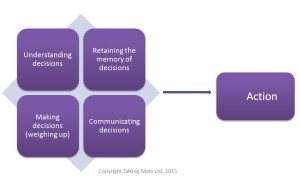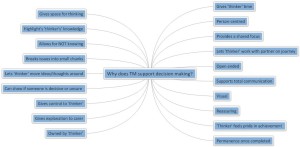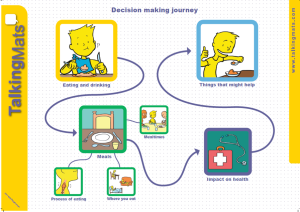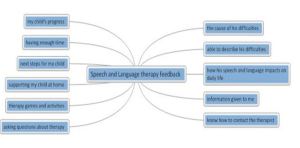What are social care outcomes and how do we measure them? The Adult Social Care Outcomes Toolkit (ASCOT) was developed over a number of years as a way of measuring user views on their social care. The ASCOT has been developed by researchers at PSSRU, University of Kent http://www.pssru.ac.uk/ascot/index.php
There are eight domains of ‘social care-related quality of life’ included in the ASCOT. These include:
- Control over daily life
- Personal cleanliness and comfort
- Food and drink
- Personal safety
- Social participation and involvement
- Occupation
- Accommodation cleanliness and comfort
- Dignity
The measure has been tested with service users from different user groups and there are a number of different versions available, including an easy-read version.
Many people with who have communication difficulties are not able to provide views via interview alone. Talking Mats is a communication tool that can be used with people who have communication difficulties. The mat consists of a set of symbols or pictures that are tailored to the subject you want to talk about.
The ASCOT Talking Mat: Tizard Centre’s Jill Bradshaw with Ann-Marie Towers and Nick Smith (both from PSSRU) have worked with the Talking Mats team at Stirling to develop three ASCOT Talking Mats. These will enable people to give their views on:
- Where I Live. This is a starter mat, designed to introduce people to the approach and for those people who might find more abstract concepts more challenging;
- My Care. People will be supported to give their views about whether aspects of their care are going well or not going well.
- Control over my Care. People will be given tools to think about how much choice they have over different aspects of their care. The second and third mats have options for both basic and more abstract concepts.
The TM version of the ASCOT will enable researchers to investigate user views regarding social care outcomes. By using this more inclusive methodology we will be able to engage with these seldom heard groups. The use of symbols in combination with a structured approach will enable us to represent these participants’ own feelings/perspectives in the research, rather than us having to rely on the views of proxies.
Researchers at the University of Kent will be piloting the ASCOT Talking Mats with people with dementia and people with intellectual and developmental disabilities (learning disabilities).
Jill Bradshaw (Accredited trainer) Lecturer in Learning Disabilities, Tizard Centre, University of Kent
Ann-Marie Towers (Research Fellow) and Nick Smith (Research Officer). PSSRU, University of Kent
We are delighted to be a Winner in the People Driven Digital Health Awards which were held in Leeds on Friday 3rd July. These awards were instigated to recognise the work of digital health innovators from across the UK and aim to connect the people who have ideas and make them happen.
The event was organised by mHabitat and compered by a well known health commentator, Roy Lilley, of the Academy of Fabulous Stuff. The evening was full of fun and energy and we met lots of interesting people and made good connections. There is loads going on in digital health and services should make use of all these fabulous innovations that will improve people’s lives and health services. To get a flavour of the evening follow #PDDAwards15 and to find out about the other winners click here.
Our category, ‘the most impressive third sector digitally enabled service’ recognises third sector services which have embedded digital tools and services into improving people’s experience and outcomes. We very honoured to win this category with our digital Talking Mat. The announcement of the winners was followed by a flurry on Twitter which you can dip into here .
Background
Social workers are required to complete a detailed assessment of their client’s needs. It is recognised that it can be a challenge to ensure clients fully participate in the process if they have cognitive or communication difficulties. The City of Edinburgh Council were keen to explore if we could adapt their standardized assessment tool and make it into a Talking Mat framework. Several staff in the council are already skilled practitioners in Talking Mats so are familiar with the framework and use Talking Mats in their practice. They are enthusiastic about the benefits of using Talking Mats both in terms of how it increases participation of service users but also because in their view it makes interviews easier for staff to undertake.
Structuring Talking Mats assessment framework
In order to develop the bespoke Talking Mat we held a seminar to discuss the social work assessment tool and approach used. Six key staff attended the seminar, facilitated by two Talking Mats associates. The discussion at the seminar identified a structure that would enable us to construct a coherent visual conversation that would cover the issues required to complete the assessment, using mind mapping to support this process. It is also important to identify a top scale that matches the question you are asking and make sure the options you are including are neutral and not leading.
The structure that emerged from this discussion is a Talking Mat that enables people to explore their views on 3 topics
- their home
- their health and well being
- their community involvement
Trialling the Talking Mats framework
Talking Mats then took the mind maps and developed these into symbol sets that were piloted by social work staff. At the end of the pilot a review was held and changes made which included alterations to
- the language used
- the symbols used
- the topic an option was included under
- making it clearer to staff when options were more abstract and required further explanation and or personalisation
Nicki Ewing from Edinburgh City Council who leads on the project says ‘ I am very excited that staff have a tool that can make assessment more meaningful for service users to participate in and makes it easier for staff to get good quality information’.
Next steps
We are thinking of holding a focus group for others that might be interested in using the framework for their practice if, you are interested please contact Lois via the info@talkingmats.com email – call your email ‘social work focus group’.
We were recently involved in a discussion about the merits of symbols versus photographs to support communication, a topic which we have spent some time considering over the past few years.
We have also found an excellent small book titled ‘Too late to drive’ by Helen J Bate and published by Pictures to Share C.I.C. In it Helen discusses the meaning of pictures and visual perception in relation to dementia. There are some excellent quotes such as ‘Recognition is not the same as relevance, and relevance is what is important to us when we have dementia’ and ‘The images that really talk to people are produced with a skill and an understanding of the visual image as a method of unspoken communication’..
Our gut feeling is that for many people who use Talking Mats (who we refer to as ‘thinkers’), symbols may be more helpful than photographs and, although we have not carried out any academic research, we have lots of anecdotal evidence from a number of practitioners about some of the pitfalls of using photos. Here are a few:
- The ‘thinker’ tends to get caught up in the detail of a photo e.g. Australian colleagues told us about using photos of different rooms in a day centre but the ‘service users’ got caught up with seeing specific details in the photos rather than considering the over place
- Sometimes a photo can be too specific e.g. we were told of a person with dementia who was shown a photo of cornflakes to represent breakfast but could only focus on the cornflakes
- The ‘thinker’ may be distracted by a photo of a real object e.g a person with learning disability fixed on the make of a particular car instead of considering transport
- We are always wary of using photos of real people as it may be too sensitive for the ‘thinker’ – symbols appear to reduce the emotion impact of the image and be easier for people to comment on
- If the person in the photo has changed, for example their hairstyle or glasses, this can confuse the ‘thinker’
- If the ‘thinker’ has been involved in the place or event in the photo this can affect their views whereas a symbol is more neutral
- Sometimes the clarity and quality of home taken photos can be poor.
- Commercial photos like Photosymbols are good quality but we are aware that they tend to be used repeatedly, sometimes for quite different meanings
Here is a link to a previous blog which gives some additional information about the development of the Talking Mats symbols.
Academic research evidence on visual images and communication is limited and Helen suggests that that ‘If the academic world wants to explore or challenge anything [in these pages] then at least the conversation has begun’. We would welcome any further information, references or comments.
Please send them to info@talkingmats.com
Handing over control of communication seems to be the most difficult of all the skills we need to have when we are taking part in communicative exchanges. Just how difficult this is, even for skilled communicators, can be clearly seen when people are using Talking Mats. Handing over control of communication is one of the fundamental principles of the talking mats framework. If the person has the physical skills, the facilitator physically hands over this control by handing the person the symbol (and of course other approaches are used when the person does not have the physical skills). The ‘thinker’ (the person who is doing the Talking Mat) then places the symbol on the Talking Mat, under one of the points on the pre-agreed top-scale, having been asked an open question e.g. how do you feel about …….?
When facilitators are learning about this approach, they seem to find it easier to ask open questions, slightly harder to stick to the agreed top scale but really difficult to hand over all of that control. As part of the training, participants film themselves using Talking Mats with someone. We use that clip to reflect on the facilitators’ skills, by taking about things that we liked and then reflecting on ‘it would have been good if…….’
The video clips work really well as participants can see themselves making the errors of retaining control in small (but nonetheless significant ways) e.g.
• Having the mat facing themselves rather than the ‘thinker’
• Moving the symbols after they have been placed by the ‘thinker’ to tidy them up/to make it easier for facilitator to see them
• Forgetting to give a neutral response where ever the symbols are placed (even if the facilitator thinks that the symbol has been ‘misplaced’)
• Telling people that they must place the symbols in rows underneath one another
• Not letting people use the top-scale creatively e.g. by placing the symbols at specific points between the top-scale e.g. to represent unsure but I am more happy with it than not.
The great thing about the Talking Mats training is that participants noticed these things that they were doing and will be working hard at noticing and doing them less in future.
We find it hard to give up control and find it hard to notice the things we do to retain this control, even when we are working within the talking mats framework. This is a framework where we are ‘symbolically’ handing over that control in the form of giving someone a symbol and so have a very obvious reminder of whose turn it is. How many ways then must we do it in everyday conversations and never notice? After all, in every day conversations, there are typically much less obvious reminders of whose turn it is and who should be in control.
Many thanks to Dr Jill Bradshaw, Lecturer in Learning Disabilities/Consultancy Development Manager, Tizard Centre, University of Kent for this thoughtful blog.
In June 2012 the Scottish Government published “A Right to Speak” (Scottish Government 2012) which included a four million pound fund to help improve services in Scotland for people who use Alternative and Augmentative Communication (AAC). At that time we were a small fledging social enterprise with a vision to improve the lives of people with communication difficulties in Scotland. We have been fortunate to be able to make our contribution to Right to Speak and as the initiative ends at the end of this month it is good to reflect on the work that we have contributed to over the past 3 years.
AAC outcomes
At the beginning we were heavily involved in the research aspect of the project, carrying out a critical appraisal of outcomes for people working in AAC. This led onto a second project to evaluate the validity and reliability of the Therapy Outcome Measure for AAC. We were pleased to be able to do this in conjunction with Prof Pam Enderby and a number of AAC professionals throughout Scotland. The Therapy Outcomes Measures, third edition has just been published which includes a section on AAC co-written with Joan and Sally. This should allow professionals to be much more specific in monitoring and measuring the impact of AAC intervention.
Quality indicators
A second piece of research we carried out was to explore what matters to AAC users in terms of service delivery. It was a great privilege to listen to the views of people who use AAC from all over Scotland and we were able to theme those views into 10 key quality indicators. This led on to one AAC partnership asking us to design a Talking Mat to enable AAC users to give feedback on their service. This was successful and NHS Education then asked us to roll that out across Scotland. 40 people have just attended 4 specialist seminars and received the resource. We believe that taking the time to listen to people and ask for feedback in a structured way is really important and so to continue to support that we are making the ‘Talking Mats AAC feedback’ script ,symbol set people and symbols set services available on the free stuff section of our web site.
Promoting Inclusion and Participation
We were fortunate to win the tender to design an online learning resource for staff working with children and young people. It is designed to help professionals take a holistic and values based approach to working with young people to support their health and wellbeing. The resource contains a collection of film clips that depict three different environments in which young people use AAC: a mainstream primary school, a mainstream high school and a specialist school. It provides a Learner’s Workbook which shows the learner how to use the film clips to improve the way they promote inclusion and participation for young AAC users. It will support equip practitioners to shift from a model of working where interventions are done to the child/young person to a process where work is done with children and families to focus on what is important to them. It is about to launch on the NHS Education web site.
Training and accredited training
There has been a significant focus on developing a well trained staff through the right to speak initiative and helping people understand about communication. We have been delighted to play our role in that. Up and down Scotland we have run training courses for different AAC partnerships e.g Lanarkshire, Fife, Highland, Western Isles, Tayside. We have also had people coming to train here in Stirling .We are particularly pleased that there have been several people who have completed their accredited trainers and who will be able to continue and sustain training in their local area. In one Health board for example, there is a plan to train a further 300 front line staff in Talking Mats
Moving forward
It’s been a busy 3 years and it’s both exciting and gratifying that so many more people know about AAC and know that it is not a responsibility that rests with just one profession . The complexity of communication means we all have to play our part but we all recognise there is still much to do to really ensure people who use AAC are fully included in society.
As a social enterprise we would no longer describe ourselves as ‘fledgling’ –we have well and truly hatched ! We are grateful that during our critical start-up period winning tenders for right to speak also helped us on our journey. We will continue to fulfil our vision of supporting people with communication difficulties and we recognise right to speak has given us a legacy of research and resources that will help us do that.
The inability to make a decision could be because of a learning disability, mental health problems, brain injury, dementia, alcohol or drug misuse, side effects of medical treatment or any other illness or disability. Click here for further information.
Both the Mental Capacity Act (2005) in England and Wales and the Adults with Incapacity Scotland Act (2000) identify the following components which determine whether or not someone has capacity to make their own decisions.
There are a number of additional assumptions that are central to determining whether or not someone has the capacity to make their own decisions:
• Every adult has the right to make decisions unless proved otherwise
• Everyone should be supported to make their own decisions
• People should be given the support they need
• People are entitled to make their decision – good or bad
• Each individual has a different capacity to make decisions about different aspects of their life.
We have been running seminars on how Talking Mats can be used to support a person’s capacity to make decisions.The diagram below illustrates some of the comments we received form participants at a recent seminar about the benefits of using Talking Mats to support decision making.
Click on the diagram to enlarge.
The process of completing a Talking Mat helps people retain their view and if they have memory problems the picture of the mat is a good prompt to enable recall.
Its worth noting that our brain processes visual images 60,000 faster than text!
Getting feedback on AAC services is particularly challenging because of the communication support needs of this group of people. It is therefore really important for AAC users to have the chance to say how they feel about the services they receive. Services need to make sure that this group of people have a voice and that there is a mechanism for their views to be taken into account in monitoring the quality of services and service planning.
NES has funded the opportunity for professionals to attend a seminar and go away with a resource to support them to get feedback from AAC users about their service. The Talking Mats resource was trialled and developed with Forth Valley AAC partnership and is based on AAC quality indicators (NES 2013).
This opportunity is free of charge to people in AAC partnerships in Scotland. You will attend a half day specialist seminar and go away with a free resource to use in practice.
The resource will help people find out how AAC users feel about:
- People who work with them
- How AAC services are delivered
It provides a model of good practice which could be extended to evaluate other services.
4 dates and locations are available.
Edinburgh- Tuesday 17th March 1.45 -4-.30pm
Dundee – Wednesday 18th March 1.45 -4.30pm
Glasgow Thursday 19th March – 1.45 -4.30pm
Inverness Friday 20th March 1.45 -4.30 pm
If you are trained in Talking Mats and wish to take up this great opportunity, please book your place as soon as possible.
sally@talkingmats.com or rhona@talkingmats.com
Recently we delivered two Talking Mats specialist seminars in London:
- Talking Mats and the Eating and Drinking resource
- Talking Mats and Capacity
Both seminars were very well attended with lots of discussion from a wide range of professionals.
During the Eating and Drinking seminar, we provided background on how and why the resource was developed and showed some DVD examples of people using the resource. This really brought things to life and showed how important it is to give people (with and without speech) the opportunity to consider and talk about different aspects of eating and drinking. We also gave people hands-on practice in using the symbols from each topic.
Each participant received a copy of the full resource, including symbols, a mat, and explanatory booklet.
During the Capacity seminar we discussed the fundamental principles the Capacity Act and participants had a chance to consider how Talking Mats can help people to:
- understand
- retain/remember
- weigh up information
- communicate their views/wishes and feelings.
They were also given the opportunity to work through some practical examples and think about options to help people understand issues and make decisions.
If you would like to attend our next specialist seminars, we are holding them in Stirling on 17th February: Stirling Seminars Feb 2015 flier
We are grateful to Nicola King SLT, who describes how she and colleagues use Talking Mats not only to gain feedback from parents about the therapy process, but also about the parent’s understanding of the child’s diagnosis and its impact.
The options to start the discussion are included in the mind map below. Click on image to enlarge.
Issues raised by one parent were
1) Information given to me –unsure . The mum went on to say ‘I’m worried/ frightened. I don’t want to ask too much as I’m frightened as to t he answers
2) My child’s progress –unsure. The mum offered ‘I’m inpatient’
Nicola commented –‘These were huge issues and each response gave me a chance to explore what she was thinking and meaning. For the first time this mum offered her fears about ASD and ADHD. She enjoyed the Talking Mats process and after the interaction agreed for the first time to an onward referral which ensured support was in place for her son starting school.
The Talking Mats format was a brilliant way to have that ‘difficult conversation’ ‘
 Online training login
Online training login 









